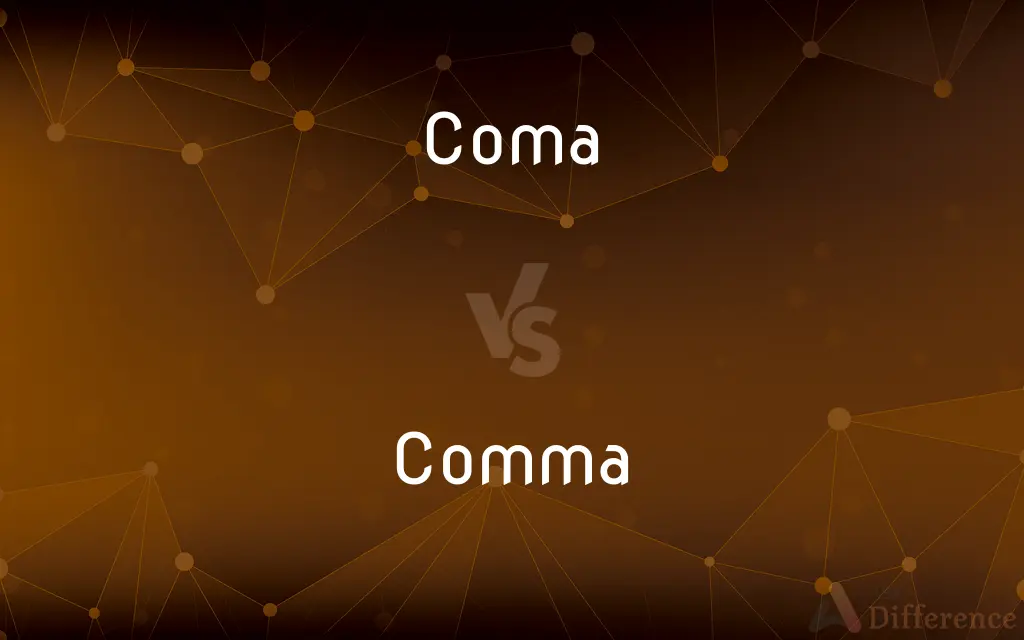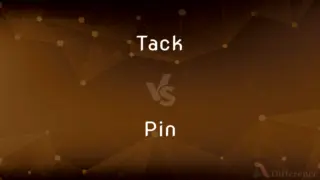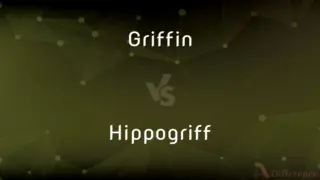Coma vs. Comma — What's the Difference?
By Maham Liaqat & Fiza Rafique — Updated on April 24, 2024
Coma is a state of deep unconsciousness, while comma is a punctuation mark used in writing.

Difference Between Coma and Comma
Table of Contents
ADVERTISEMENT
Key Differences
Coma refers to a medical condition where a person is unresponsive to their environment due to various causes like trauma or illness. In contrast, a comma is used in grammar to indicate a pause between parts of a sentence or to separate elements in a list.
In healthcare, dealing with a coma involves monitoring and treatment to support life functions and possibly aid recovery, highlighting the seriousness of the condition. A comma, however, plays a crucial role in clarifying meaning in written language, preventing misinterpretations and ensuring the text flows logically.
The duration and implications of a coma can vary, ranging from temporary to permanent effects on brain function, depending on the severity of the underlying cause. Meanwhile, the use of a comma can dramatically alter the meaning of sentences, such as differentiating between "Let's eat, grandma!" and "Let's eat grandma!"
Understanding a coma requires medical knowledge and often involves sophisticated healthcare interventions. Understanding the correct use of a comma requires knowledge of language rules and is essential for effective written communication.
While a coma represents a critical and potentially life-threatening medical emergency, a comma represents a fundamental element of grammar that, although less dramatic, is vital for clear communication.
ADVERTISEMENT
Coma and comma are examples of homophones in English—words that are pronounced the same but have different meanings and spellings, each belonging to vastly different contexts: medical for coma and linguistic for comma.
Comparison Chart
Definition
A state of deep unconsciousness.
A punctuation mark used to indicate a pause.
Usage
Medical context to describe unconscious states.
Writing, to separate items or clauses in sentences.
Implications
Can be life-threatening, requires medical intervention.
Essential for clarity and flow in writing.
Example
A patient may fall into a coma after a severe head injury.
A comma is used before "and" in a list of items.
Educational Focus
Studied in medicine and healthcare.
Studied in grammar and language arts.
Compare with Definitions
Coma
Medical condition of deep unresponsiveness.
The severity of the brain injury led to a coma.
Comma
Essential in setting off introductory elements.
After the meeting, we went for dinner.
Coma
Often results from significant head trauma or brain damage.
The boxer suffered a coma after the knockout blow.
Comma
Helps clarify meaning by separating elements.
To avoid confusion, use a comma before the conjunction in a complex series.
Coma
A state where a patient is unresponsive to external stimuli.
Despite loud noises, the patient in a coma showed no reaction.
Comma
Can connect independent clauses with conjunctions.
She finished her homework, and then she went to the movies.
Coma
A prolonged state of unconsciousness.
After the car accident, he was in a coma for three weeks.
Comma
Used in dates, addresses, and numbers for clarity.
The letter was postmarked December 5, 2023, New York, NY.
Coma
A serious medical emergency requiring intensive care.
The patient in a coma was placed in the ICU immediately.
Comma
A punctuation mark used to indicate a pause.
In the sentence, “We bought eggs, milk, and bread,” a comma separates the list items.
Coma
A coma is a deep state of prolonged unconsciousness in which a person cannot be awakened, fails to respond normally to painful stimuli, light, or sound, lacks a normal wake-sleep cycle and does not initiate voluntary actions. Coma patients exhibit a complete absence of wakefulness and are unable to consciously feel, speak or move.
Comma
The comma , is a punctuation mark that appears in several variants in different languages. It has the same shape as an apostrophe or single closing quotation mark (’) in many typefaces, but it differs from them in being placed on the baseline of the text.
Coma
A state of deep, often prolonged unconsciousness, usually the result of injury, disease, or poison, in which an individual is incapable of sensing or responding to external stimuli and internal needs.
Comma
(Grammar) A punctuation mark ( , ) used to indicate a separation of ideas or of elements within the structure of a sentence.
Coma
(Astronomy) The nebulous luminescent cloud surrounding the nucleus of a comet and composed of material evaporated from the nucleus when the comet is near the perihelion of its orbit. The nucleus and coma together form the head of a comet.
Comma
A pause or separation; a caesura.
Coma
(Botany) A usually terminal tuft or cluster, especially a tuft of hairs on a seed, as on a willow or milkweed seed.
Comma
Any of several nymphalid butterflies of the genus Polygonia having wings with irregularly notched edges and a small comma-shaped marking on the underside of the hind wing.
Coma
(Physics) A diffuse, comet-shaped image of a point source of light or radiation caused by aberration in an optical system.
Comma
(typography) The punctuation mark ⟨,⟩ used to indicate a set of parts of a sentence or between elements of a list.
Coma
A state of unconsciousness from which one may not wake up, usually induced by some form of trauma.
Go into a coma
Slip into a coma
Come out of a coma
Comma
A similar-looking subscript diacritical mark.
Coma
(astronomy) A cloud of dust surrounding the nucleus of a comet.
Comma
(entomology) Any of various nymphalid butterflies of the genus Polygonia, having a comma-shaped white mark on the underwings, especially Polygonia c-album and Polygonia c-aureum of North Africa, Europe, and Asia.
Coma
(optics) A defect characterized by diffuse, pear-shaped images that in an ideal image would appear as points.
Comma
(music) A difference in the calculation of nearly identical intervals by different ways.
Coma
(botany) A tuft or bunch, such as the assemblage of branches forming the head of a tree, a cluster of bracts when empty and terminating the inflorescence of a plant, or a tuft of long hairs on certain seeds.
Comma
(genetics) A delimiting marker between items in a genetic sequence.
Coma
A state of profound insensibility from which it is difficult or impossible to rouse a person. See Carus.
Comma
(rhetoric) In Ancient Greek rhetoric, a short clause, something less than a colon, originally denoted by comma marks. In antiquity it was defined as a combination of words having no more than eight syllables in all. It was later applied to longer phrases, e.g. the Johannine comma.
Coma
The envelope of a comet; a nebulous covering, which surrounds the nucleus or body of a comet.
Comma
(figurative) A brief interval.
Coma
A tuft or bunch, - as the assemblage of branches forming the head of a tree; or a cluster of bracts when empty and terminating the inflorescence of a plant; or a tuft of long hairs on certain seeds.
Comma
A character or point [,] marking the smallest divisions of a sentence, written or printed.
Coma
A state of deep and often prolonged unconsciousness; usually the result of disease or injury
Comma
A small interval (the difference between a major and minor half step), seldom used except by tuners.
Coma
A usually terminal tuft of hairs especially on a seed
Comma
A punctuation mark (,) used to indicate the separation of elements within the grammatical structure of a sentence
Coma
(astronomy) the luminous cloud of particles surrounding the frozen nucleus of a comet; forms as the comet approaches the sun and is warmed
Comma
Anglewing butterfly with a comma-shaped mark on the underside of each hind wing
Common Curiosities
What causes a person to go into a coma?
Causes of a coma can include severe head injuries, strokes, brain tumors, drug or alcohol poisoning, and certain illnesses.
How long can a coma last?
The duration of a coma can vary widely from a few days to several years, depending on the cause and severity.
What is the purpose of a comma in a sentence?
A comma serves to clarify the meaning of sentences, separate items in a list, connect independent clauses, or set off non-essential information.
Can the misuse of a comma change the meaning of a sentence?
Yes, incorrect comma usage can lead to misunderstandings and change the intended meaning of a sentence.
What is the main difference between a coma and a comma?
A coma is a medical condition characterized by deep unconsciousness, while a comma is a punctuation mark used to indicate pauses and separate elements in writing.
How can one improve comma usage?
Improving comma usage involves learning grammatical rules, reading extensively, and practicing writing with feedback from knowledgeable sources.
What are the recovery chances from a coma?
Recovery from a coma depends on the coma's cause, duration, and severity, as well as the individual's overall health and age.
How can educators teach effective comma usage?
Educators can teach comma usage through direct instruction, examples, and providing ample practice with feedback to ensure students learn to use commas effectively in their writing.
Is comma usage the same in all types of English?
Comma rules can vary slightly between American, British, and other types of English, particularly in the usage of the Oxford comma and in dates and addresses.
How is a coma treated?
Treatment of a coma involves addressing the underlying cause, supporting vital functions like breathing and circulation, and often requires care in an intensive care unit.
Share Your Discovery

Previous Comparison
Tack vs. Pin
Next Comparison
Griffin vs. HippogriffAuthor Spotlight
Written by
Maham LiaqatCo-written by
Fiza RafiqueFiza Rafique is a skilled content writer at AskDifference.com, where she meticulously refines and enhances written pieces. Drawing from her vast editorial expertise, Fiza ensures clarity, accuracy, and precision in every article. Passionate about language, she continually seeks to elevate the quality of content for readers worldwide.













































